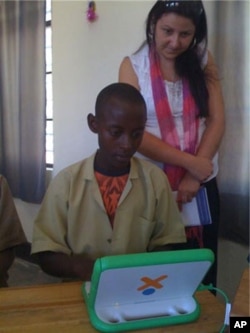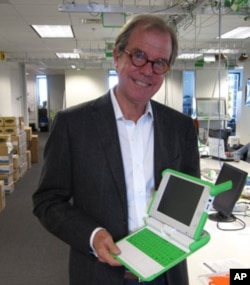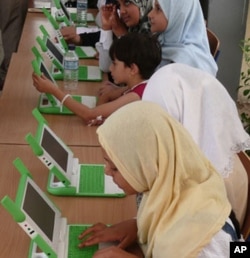One Laptop Per Child's office feels more like a playroom for geeky adults than a non-profit with a mission to save the world.
Plastic green laptops are strewn about in various stages of disassembly and upgrade, and the office is decorated with multicolor engineering and distribution charts, all organized by a young enthusiastic staff.
Dreaming big
Founder Nicholas Negroponte dreams big. His goal is to provide laptops to all the world's children, especially the half-billion or more who live in extreme poverty. "We invented a technology that was low cost enough that these laptops could be owned by the children, brought home and used for music, games, movies, books and learning 24/7," he says.
Almost a decade ago, when OLPC began, the idea of designing and manufacturing a rugged, laptop computer for anything close to $100 seemed laughable to some. Today, the device is already in the hands of 1.2 million children in 31 countries who speak 19 languages. One nation, Uruguay, has just completed delivery of laptops to every single child in the country.
Few doubt that giving children access to computers is a good thing. But buying the tens of millions of laptops many countries need can be expensive, even at the current price of $160 each. Critics of Negroponte's approach say there are cheaper and more efficient ways to deliver computing power to the world's children than to put a laptop literally into each child's hands.
A better way?
Steven Dukker, a pioneer in low-cost computing technology, is one of those critics. He founded nComputing, a company that makes software and hardware that allow a single, $300 desktop computer to run programs and applications for dozens of students at the same time.
NComputing networks are now in use at 40 thousand sites in 100 countries, including the United States. "You think you've got your own computer all to yourself," explains Dukker, "and you can't tell … that you're working on something other than a computer … and doing it at a much lower cost than having your own PC."
But Negroponte believes that when a child has his own laptop, it provides a personal connection to the technology, and to the use of that technology, that a terminal in a computer lab cannot.
A computer of their own
"Our kids take the laptops home at night and sleep with them. It's their most cherished possession. It's a very different phenomenon," he says.
Matt Keller, OLPC's global advocacy director, says the real reason kids love their laptops so much is because they quickly learn to start customizing them to suit their own purposes.
"Up until the age of five, children learn in a very dynamic, engaging way," says Keller. "They learn how to walk and talk and they build things and they make mistakes and they knock them down, they lose their tempers, and they build them back up again. But they are learning through that dynamic interaction with things around them." Keller contrasts this with the rote memorization many children must do in their traditional schools.
Making a difference
Keller recalls a class of 12 year-old girls in Rwanda, where the president ordered the purchase of 120,000 laptops for the country's children. Within days of receiving their machines, these rural girls had become experts at a programming game where they could design characters, dress them, make them do things, and tell stories together.
"I thought to myself 'If you have a generation that's capable of designing software, of building things with technology and they are connected, why couldn't you a have a Silicon Valley in the middle of the most remote place on earth?'"
The main difficulty seems to be securing the funding and safe distribution for large numbers of computers in poor countries facing war and poverty; places like Afghanistan. "The Afghani government desperately wants OLPC for it citizenry," says Keller. "The Ministry of Education says OLPC will end the isolation of its citizens. The UN in Afghanistan says this is the solution for girls' education in Afghanistan."
Negroponte believes that, in addition to educating children, the computers enable both girls and boys to become agents for social change. "We find in Peru that as many as 50 percent of the kids, because they are in remote villages, are teaching their parents how to read and write."
He says evidence suggests that, in communities and schools worldwide where OLPC has made inroads, discipline problems go down, parents become more involved and kids literally 'run to school'. "And," adds Negroponte, "in some of our earliest projects, in 2001 and 2002, every child that was in that experiment in first and second grade is still in school today. And that kind of impact, to me, is extraordinarily heartwarming."
It's clear that various factors market forces, technical breakthroughs, local communication networks and, most importantly, political will, must be aligned before all children get their hands on the tools they need to thrive and contribute in our interconnected world. Still, One Laptop Per Child is doing everything it can, one laptop computer at a time.












